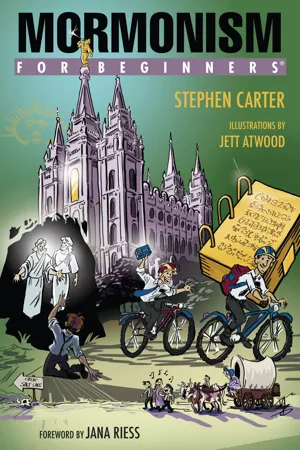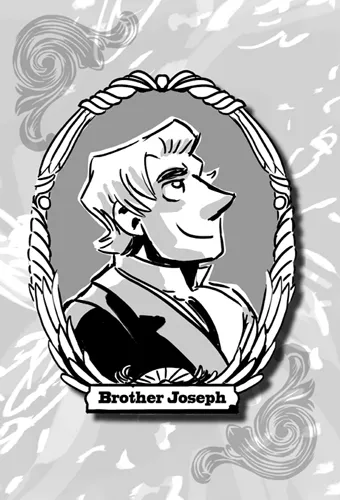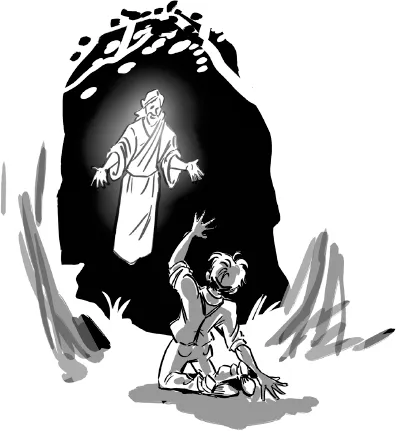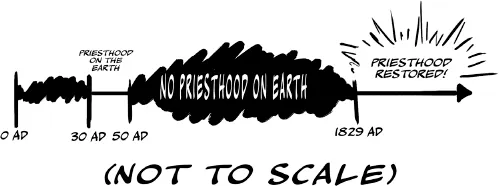![]()
part 1
MORMON HISTORY
![]()
JOSEPH SMITH
Make no mistake. Mormons consider Joseph Smith, the founder of Mormonism, to be the greatest prophet in world history, ranking second only to Jesus Christ. This is an extraordinary claim that raises the question: Just what is a prophet?
Some might consider prophets to be serene people whose reputations are ever spotless—people who establish only peace around them, whose every step seems blessed by God. But that was not Joseph Smith. His explosive brand of prophethood broke down social and theological walls, mended millennia-old rifts in human and cultural understanding, and threw itself against the limits of the heart's capacity. Those who interacted with Joseph Smith were inevitably drawn into his intense, frequently overwhelming maelstrom. And in that tempest, they either lost themselves or found themselves. Sometimes both. Joseph's life was a holy storm—both vitalizing and disrupting—whose potency still draws people into its heart almost 200 years after his death. Smithsonian Magazine in 2015 ranked Joseph Smith as the most influential religious figure in American history.
Early Life
Born on December 23, 1805, Joseph Smith grew up in upstate New York in what was called the “burned-over district,” so named for the numerous tent revival meetings that swept through the area. Though his family was religious, they weren't attached to a particular church and often participated in these revivals.
Joseph and his family were also very much into folk magic, which often blended into frontier Christianity. Joseph frequently took night-time excursions around the forest, leading groups of people with a divining rod or peep stone (also called a seer stone) and performing elaborate rituals in an attempt to detect hidden treasures beneath the ground.
Joseph was also obsessed about which, if any, of the Christian churches in his area possessed the whole truth. His search for that answer leads us to Mormonism's foundational story: the First Vision.
The First Vision
Though the First Vision of 1820 is at the base of Mormonism's conception of itself, Joseph Smith never actually committed the story to paper until 1832, two years after he founded the LDS Church. In that earliest version, he describes his 16-year-old self (though he was actually 14 if the vision took place in 1820) as being disenchanted with the churches he had come into contact with, feeling that that none of them had the truth. He describes going into the forest near his home in the town of Palmyra, praying about the matter, and being visited by the “Lord,” whom Smith records as saying, “behold the world lieth in sin at this time and none doeth good no not one they have turned aside from the gospel and keep not my commandments.” (Letterbook 1, The Joseph Smith Papers)
In 1835, Smith recounted his vision again to a religious charismatic named Robert Matthews. In this telling, Smith says that he had been merely perplexed by the different denominations (instead of being convinced that they had no truth) and had been inspired by Matthew 7:7 and James 1:5 to seek divine answers. He goes into the woods to pray but, in this account, has difficulty doing so: his tongue swells in his mouth and he becomes frightened by the sound of footsteps behind him. Soon, a “pillar of fire” descends over him, illuminates the forest, and fills him “with joy unspeakable.” One “personage” stands in the pillar of fire for a fleeting moment; then another one descends, telling Joseph that his sins are forgiven and testifying of Jesus Christ. Joseph also sees angels. (Journal, 1835–1836, The Joseph Smith Papers)
But the story that eventually became the accepted version among Mormons was written as a part of Joseph Smith's official history in 1838. This narrative is the most detailed. First, it spends a good amount of space describing how the Second Great Awakening—the Protestant revival movement that swept America during the first decades of the 19th century—affected young Joseph. Seeking the true faith, Smith runs across James 1:5, which reads, “If any of you lack wisdom, let him ask of God, that giveth to all men liberally, and upbraideth not; and it shall be given him.”
And so, according to the official version of the First Vision, on the “morning of a beautiful, clear day, early in the spring of eighteen hundred and twenty,” young Joseph Smith walks into a grove of trees and, for the first time in his life, begins to pray vocally. “I had scarcely done so,” he continues, “when
And then he pens the words that have launched a million Mormon missionary lessons:
When Joseph regains possession of himself, he asks the two Personages which church he should he join. As he recounts,
A few days later, Joseph recounted his vision to a local preacher, who “treated my communication not only lightly, but with great contempt, saying it was all of the devil. . . .” (History 1:21) Indeed, Joseph said that he suffered a good deal of persecution over the years for talking about his vision. (It seems people didn't react well to being told that their religion is an abomination!)
In 1842, Joseph penned his final version of the story in what came to be called the Wentworth Letter. It's pretty much an abbreviation of the 1838 version, but with the added detail that the
These various accounts of the First Vision have caused a great deal of debate between Mormons and their critics. Joseph Smith seems to have told different stories each time, beginning with one heavenly being, then adding another, and then sprinkling in some angels—not to mention failing to describe the demonic attack the first time around. Many theories have been advanced to explain these differences, but there is little doubt of the narrative's potency. It is probably the most-told story in Mormonism.
The Great Apostasy
All of this raises the question, why did God need to visit Joseph Smith and tell him all of the churches are wrong in the first place? Mormons came to explain this as the Great Apostasy.
It was the killing of Jesus's original apostles that led to this falling away: a period of about 1,700 years during which God's priesthood was found nowhere in the Eastern Hemisphere. (It was extant in the Americas, but we'll get to that in the...








